
Wine Culture and Information since 2002 - Volume 22
 Wine Culture and Information since 2002 - Volume 22 |
|
Issue 203, February 2021 |
Contents |
|
|
The Italian Wine and the 2020 |
|
The year that has just passed, 2020, represented for the world of wine – and not only for that – a decidedly difficult and critical period, of which we all were aware of. In this particular and unpredictable period, it is difficult to talk about anything else as the impact the current situation is exerting on the world of wine, including the economic, health and social ones, will need a long time to recover. During 2020, it has been forecast a consistent decline in sales, many estimates were made, unfortunately confirmed by the real data that have gradually defined the actual economic loss of the wine business and related activities. In this initial period of 2021, of course, the loss and profits of the wineries are being defined more clearly, not only in regard to the actual losses caused by lost sales, but also the estimate of what – as a matter of fact – has not been sold and still stored in wineries. An estimate of the amount of wine still stored in the Italian wineries has been provided by a report recently released by the ICQRF, Ispettorato Centrale della Tutela della Qualità e Repressione Frodi dei prodotti agro-alimentari, the Central Inspectorate for the Safeguarding of Quality and Fraud Repression of agriculture and food products, a department within the Italian Ministry of Agricultural and Food Policies. The figures emerging from this document are, in truth, quite huge and – it should be said – they include the total quantity of wine by destination and enological type. This means it includes both wines destined to the market, so to speak, for immediate consumption and in the course of the current the year, and those destined, either by wine making choice or production requirement, to an aging before being marketed. Last but not least, also the wines of vintage 2020 that are still in the process of production. The data emerging from this report are very interesting and useful for understanding the “wine geography” of Italy and how the production is distributed in the country, in particular, in quantitative terms. The estimate was made by evaluating the data contained in the electronic registry about wine production in Italy, that is the database managed by the Italian Ministry of Agricultural and Food Policies. The registry contains the production data relating to about 17,000 producers and lists about 650,000 wine vessels, for a total of about thirty million recorded operations per year. The ICQRF estimates this database lists at least 95% of the wine which is currently kept by the wineries in Italy. At 31 December 2020, according to the data recorded in this electronic registry, in Italy there are currently 60.9 million hectoliters of wine, 8.3 million hectoliters of musts and 2.8 million hectoliters of new wine and still in the fermentation process. The first figure that emerges, in particular, is the comparison with the end of 2019. In fact, it can be seen an increase in stocks of 4.4%, a reduction of 8.5% of musts and 10% for wines in fermentation. These preliminary data highlight what has already been known for months: the decline in sales of wine vintage 2019 and past vintages as well as the decrease in production for vintage 2020. This latter figure was easily predictable, indeed, so to speak, ”forced” by the measures implemented in the past months and specifically for wine production which foresaw, in fact, a decline in viticultural production, and therefore in wine of vintage 2020. Moreover, there is another significant figure emerging from the comparison with the data about the end of November 2020. As was easily predictable, the stock of wines has increased – exactly, by 22.5% – in addition to the understandable decrease in musts, reduced by 28.5%, and that of wines in fermentation – recording a decrease of 78.3% – a sign, of course, they have ended this specific production phase. Of course, the 22.5% increase in stocks in just one month is not a fact to be underestimated and unfortunately confirms the critical moment that wineries are going through. The ICQRF report also provides interesting information about the geographical distribution of the Italian wine heritage. At the end of 2020, data say 58% of all Italian wine is stored in the wineries of northern Italy, 14.2% in the central area, 19.2% in the south and the remaining 8.4% in the islands. This report also highlights that 50.5% of the wine stored in Italian wineries belongs to the category of Denomination of Protected Origin (DOP), 27.4% is Protected Geographical Indication (IGP), 1.3% is represented by varietal wines and the remaining 20.8% is about wines belonging to other categories. Furthermore, it is interesting to note that 57% of the total stock is represented by 20 specific denominations only, as we will see in detail shortly. It is also interesting to note that 25.4% of the total wine stored in Italy is found in Veneto, in particular, the province of Treviso holds 10.6% and that of Verona 9.2%. An important share is held in Emilia-Romagna – 12.2% – followed by Apulia with 10.8%, then Tuscany with 9.3%. Piedmont and Sicily follow both with 7.3% and Abruzzo with 5.7%. As for wines with DOP and IGP denominations, data show there is a higher percentage of red wines, respectively 49.4% and 53.9%. As far as denomination wines are concerned, it is interesting to note that, despite the fact there are 525 legitimately recognized geographical indications in Italy, 57.6% of all this wine actually belongs to 20 appellations only. At the top of the ranking of the major producers, we find the vast Prosecco DOC denomination with 4.5 million hectoliters, representing 9.6% of all the appellation wines in Italy. Then follows Apulia IGP with 2.3 million hectoliters (4.8%), then Sicilia DOC with 1.8 million hectoliters (3.9%) and Terre Siciliane IGP, also in this case with 1.8 million of hectoliters (3.9%). Followed by Veneto IGP with 1.7 million hectoliters (3.7%), Delle Venezie DOC with 1.6 million hectoliters (3.4%), Toscana IGP with 1.6 million hectoliters (3.4%), Montepulciano d'Abruzzo DOC with 1.54 million hectoliters (3.3%), Salento IGP with 1.4 million hectoliters (3.1%) and Rubicone IGP with 1.3 million hectoliters (2.8%). Then follow three DOCGs wines: Chianti with 1.3 million hectoliters (2.7%), Conegliano Valdobbiadene Prosecco with 0.9 million hectoliters (1.9%), then Chianti Classico with 0.8 million hectoliters (1.7%). By Continuing to read the ranking, we have another denomination of Veneto – Veronese IGP – with 0.78 million hectoliters (1.7%), then Emilia IGP with 0.67 million hectoliters (1.4%), Valpolicella DOC and Tre Venezie IGP, both with 0.6 million hectoliters (1.3%). They are followed by another DOCG – Franciacorta – with 0.6 million hectoliters (1.3%) and Trentino DOC with the same values. At the end of the ranking of the top twenty denominations, we have Barolo DOCG with 0.5 million hectoliters (1.1%). The situation reported the 31 December 2020 includes, as already mentioned, the wines currently in production, however the quantity stored in the Italian wineries is decidedly considerable. In particular for the fact it is also made up of the unsold wine during 2020 and for which, of course, it will be necessary to find a destination somehow. We therefore enter 2021 with the very heavy burden of 2020 and to which is added the wine currently in production and which – likewise – must be placed on the market. With the release of the wines of vintage 2020 and destined to the immediate consumption – very likely, in a few months – the similar wines of 2019 and still held in the wineries will no longer have a market, because, as usual, everyone will prefer to buy the wines of the new vintage. The course of 2021 will tell us how things are actually going to be, while hoping, in any case, there can be a prompt recovery and in all areas. As we are waiting for this to happen, let's support the Italian wine – as much as we can – and raise the glasses! Antonello Biancalana
|
||||
Contrasts of Moscato di Terracina and Alto Adige GewürztraminerThe two aromatic white berried grapes compared in the glasses of this month's tasting by contrast |
|
Aromatic grapes, meaning those really belonging to this restricted category, are undeniably capable of making wines of remarkable charm and elegance. The exuberant characteristic of their wines of expressing an intense aroma of grapes to the nose – in particular and specifically, of grape juice – gives the aromatic varieties a personality, so to speak, special and rare, also thanks to the fact there are only three varieties belonging to the category of the so-called “aromatic grapes ”: Muscat, in its many biotypes, Gewürztraminer and Brachetto. To this restricted category, some also add the huge family of Malvasia grapes which, in certain cases, biotypes and territories, can actually produce wines that, to the nose, express a scent of grape juice. Specifically, these are wines with an intensity of primary aroma of grape juice rather modest if compared with the wines made from the three primary aromatic grapes. For this reason, some proposed the idea – which has never been adopted unanimously – of creating the new category of semi-aromatic varieties, to which would belong the grapes which wines recall the primary aroma of grape but not in a dominant way, including Malvasia grapes. This month, in our tasting by contrast, we will compare the two white aromatic varieties par excellence: Muscat and Gewürztraminer. When we talk about Muscat, it is actually better to refer to its large family which is made up of different biotypes, all characterized by the quality of making wines with a strong aroma of fresh grape juice. We will focus on a particular biotype – Moscato di Terracina, a famous variety of the homonymous territory in the province of Latina, Italy – and on the expression offered by Gewürztraminer in its favorite territory and which, not surprisingly, is also considered to be its land of origin: Alto Adige (South Tyrol).
|
|
The territory of Terracina – in the province of Latina – despite being today associated with the enological success of the homonymous Muscat grape, has a long viticultural and wine making tradition. In fact, there are many historical documents proving Terracina's bond with wine, dating back to the 1400s, however it is believed viticulture was introduced in these places by the ancient Greeks. The dominant grape of Terracina is undeniably Muscat, which presence in this area was already deeply rooted at the times before the arrival of phylloxera. Because of the advent of this parasite, Moscato di Terracina underwent a progressive decline, even risking its disappearance, also because of the replanting of other varieties. Thanks to the tenacious and passionate work of some producers, Muscat grapes have today reconquered the enological scene of Terracina, proving a remarkable quality with the production of wines and in different styles, from sparkling to sweet wines, from dry to slightly sweet ones. Moscato di Terracina is a biotype belonging to the large family of Muscat grapes which, in all probability, has undergone an adaptation to this territory and became a biotype in itself. The origin of Moscato di Terracina is not very clear and, although there are many similarities with Muscat of Alexandria – known in Sicily as Zibibbo – the analogy has never been proven. Another theory believes it is similar to Moscato Giallo, but, even in this case, there are no reliable evidences. Given its uniqueness and for the fact it is found only in this territory, Moscato di Terracina is therefore considered as a specific biotype belonging to the Muscat family of grapes. It should be noted that Moscato di Terracina is considered a dual-purpose variety, as it is used both as a table grape and for the production of wines. The production area is recognized as a Denominazione d'Origine Controllata (Denomination of Controlled Origin, DOC) and takes the name of Terracina or Moscato di Terracina, and includes all the territories of the municipalities of Monte San Biagio, Terracina and Sonnino, all in the province of Latina.
|
||||
|
Alto Adige is indisputably one of the Italian regions with the most marked vocation for the production of white wines. Favored by particular climatic conditions, mainly with mild temperatures and typically mountain meteorological factors, the territory is well suited to the cultivation of white grapes which give wines with a remarkable elegance and finesse. There are, of course, extraordinary examples of red grapes and wines which in Alto Adige, thanks to the particular environmental and climatic conditions, express remarkable peaks of excellence. The moderate temperatures certainly help the aromatic expression of many white grape varieties, especially those which, in areas characterized by a hot climate, make wines with ordinary aromas. One of the varieties reaching levels of absolute excellence in this region certainly is Gewürztraminer, a grape of powerful aromatic exuberance and which originates in Alto Adige, specifically, in Termeno, the Italian name of the Tramin village. The name of this variety is made from the union of two German language terms: gewürz, literally “spice” and which, in this case, would take the meaning of “aromatic”, and traminer, that is, coming from Tramin. The literal translation would therefore be “aromatic from Tramin”, usually called “Aromatic Traminer”. Gewürztraminer is supposed to be the result of the crossing of wild vines from central and eastern-central Europe, becoming, over the time, a specific variety with a strong primary aroma of grape juice. However, the history of Gewürztraminer is not clear, and it is supposed to have arrived in Termeno after a long journey, made up of adaptations and crossings, from Alsace, assuming – moreover – the derivation from the Savagnin Blanc variety, the famous white grape used for the renowned Vin Jaune of the French Jura. However, the history of this variety remains uncertain and difficult to determine also because of the instability of its genome. In Alto Adige – and this is a certainty – Gewürztraminer proves to have perfectly adapted itself to the environment, by making wines of absolute excellence.
|
We are about to start this month's tasting by contrast and, before pouring the wines into the glasses, we will pick the bottles we are going to evaluate. Moscato di Terracina and Alto Adige Gewürztraminer are not difficult to find in shops, however we should consider, in any case, that the South Tyrolean wine is certainly easier to find than the one from Latium. In both cases, we will choose wines belonging to the most recent vintage in order to have wines capable of fully expressing their aromas without the influence of the evolution of time. As for the wine making production technique, we will make sure both Moscato di Terracina and Alto Adige Gewürztraminer are produced in inert containers, in particular, in steel tanks. It is – in truth – the most frequent wine making procedure for these two wines and, generally speaking, for those produced with aromatic varieties, in order to keep the primary quality of aromaticity. The wines are poured into their respective tasting glasses at a temperature of 10 °C (50 °F). Let's pour Moscato di Terracina and Alto Adige Gewürztraminer in the glasses and let's start this month's tasting by contrast, proceeding with the appearance examination of the wine produced in the province of Latina. Let's tilt Moscato di Terracina's glass over a white surface – a sheet of paper is enough – and evaluate the color of the wine, observing the base of the glass. We can clearly see a straw yellow color with hints of gold and the transparency, evaluated by placing an object in contrast between the glass and the white surface, is decidedly very high. The nuance of Moscato di Terracina, observed at the edge of the glass, towards the opening where the wine becomes thin, confirms the straw yellow color. Let's move on to the evaluation of the appearance of Alto Adige Gewürztraminer, observing the color at the base of the glass. We see an intense straw yellow color, often golden, generally deeper and darker than Moscato di Terracina. Transparency is, also in this case, very high while the nuance of Alto Adige Gewürztraminer, observed at the edge of the glass, shows an evident golden yellow hue. Welcome to the world where everything smells of grapes. Wines produced with aromatic varieties are in fact characterized by the intense expression of the primary aroma of the grape, more specifically, of fresh grape juice. It is a quality belonging, in fact, only to real aromatic varieties, a category to which both Muscat and Gewürztraminer belong. These wines are easily recognizable thanks to the powerful intensity of this specific aroma and which is not perceivable – with the same strength and dominance – in all the other wines. Wines produced with aromatic varieties, of course, are also much more than the charming aroma of grapes and certainly capable of expressing even rather complex olfactory sensations. In this regard it must be said that, despite the aromatic varieties can, in some way, guarantee an advantage in the olfactory pleasantness of a wine, the complexity, richness and beauty of these wines is actually obtained only by adopting high quality viticultural and enological practices. In fact, in wines of mediocre and ordinary quality produced with aromatic varieties, the perception of the primary aroma is the only notable quality, although it is neither intense nor clean, simply confused in the lack of elegance of the entire olfactory profile. Let's resume our tasting by contrast of this month and proceed with the evaluation of the olfactory profiles of Moscato di Terracina and Alto Adige Gewürztraminer. In this regard, it is necessary to make a premise. The superficial evaluation of these wines could make one think the similarities are greater than the differences, in particular, because of the intensity of the primary aroma of grape. Indeed, in the sensorial evaluation of these wines, the “difficulty” is represented by the ability of analyzing the organoleptic sensations beyond the primary and initial grape aroma. The first wine of which we evaluate the olfactory profile is Moscato di Terracina. Let's hold the glass in vertical position and do the first smell in order to evaluate its opening. From the glass we perceive – clean, intense and powerful – the aroma of grape followed by peach, sage and apple. After having swirled the glass and did the second smell, the olfactory profile of the wine from Latium is completed with apricot, lychee, banana, citrus fruits and, often, a hint of almond. Let's now evaluate the opening of Alto Adige Gewürztraminer: from the glass we perceive, also in this case very powerful and intense, the primary aroma of grape followed by peach, white rose and lychee. After having swirled the glass and did the second smell, the profile of Alto Adige Gewürztraminer is completed with apricot, mango, honey, pineapple, sage, candied fruit and pear. Let's move on to the evaluation of the gustatory profiles of the two wines of our tasting by contrast, starting, as in the previous phases, from Moscato di Terracina. Let's take a sip of the wine from Latium and examine its attack, that is the preliminary and identifying gustatory sensations of the wine. In the mouth we perceive a pleasing crispness given by acidity as well as a good structure, although not so robust. Balance is obtained thanks to the effect of alcohol and the pleasing roundness of Muscat. In the mouth we can perceive – clean and intense – the flavors of grape juice, peach and apple. Let's now evaluate the taste profile of Alto Adige Gewürztraminer and take a sip of this wine in order to appreciate its attack. In the mouth we perceive the clean and pleasing crispness of acidity that finds balance both with the effect of alcohol and roundness, more intense than Moscato di Terracina. The structure of Alto Adige Gewürztraminer is also fuller than the one of the wine from Latium. In the mouth are clearly perceived the flavors of grape, lychee, peach and apricot. We are about to end this month's tasting by contrast, therefore proceed with the evaluation of the final sensations of the two wines, in particular the taste-olfactory persistence, primary factor of sensorial quality. As in the previous phases, let's start with the evaluation of Moscato di Terracina. The finish of the Latium wine is of good persistence, leaving a pleasing sensation of crispness in the mouth, given by the acidity, and a modest roundness. In the mouth we still clearly perceive the flavor of grape as well as peach and apple. Let's now pass to the evaluation of the Alto Adige Gewürztraminer's finish. Also in this case we can perceive a good persistence, in which we get the pleasing crispness of acidity, supported by an accentuated sensation of roundness. In the mouth we also perceive, intense and pleasing, the flavors of grape, peach, lychee and banana. Two wines produced with grapes belonging to the same category, that of aromatic varieties, however very different from each other, with the only element in common represented by the aroma of grape juice, but definitely distant and not only for geographical reasons.
|
||||||||
Wines of the Month |
|
|
|
Score legend Prices are to be considered as indicative. Prices may vary according to the country or the shop where wines are bought |
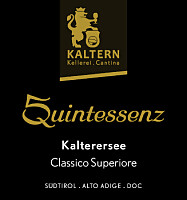
|
|
Lago di Caldaro Classico Superiore Quintessenz 2019 |
|
| Kellerei Kaltern - Caldaro (Alto Adige, Italy) | |
 Schiava Schiava | |
| Price: € 12.90 | Score: |
 Brilliant ruby red and nuances of ruby red, moderate transparency. Brilliant ruby red and nuances of ruby red, moderate transparency. Intense, clean, pleasing and refined, starts with hints of cherry,
strawberry and raspberry followed by aromas of rose, violet, plum,
cyclamen, carob, almond and vanilla. Intense, clean, pleasing and refined, starts with hints of cherry,
strawberry and raspberry followed by aromas of rose, violet, plum,
cyclamen, carob, almond and vanilla.
 Properly tannic attack and however balanced by alcohol, good body,
intense flavors, agreeable. Properly tannic attack and however balanced by alcohol, good body,
intense flavors, agreeable.
 Persistent finish with flavors of cherry, raspberry and strawberry. Persistent finish with flavors of cherry, raspberry and strawberry. 6 months in cement tanks and cask. 6 months in cement tanks and cask. |
|
 Pasta with meat and mushrooms, Cold cuts, Sauteed meat, Mushroom soups Pasta with meat and mushrooms, Cold cuts, Sauteed meat, Mushroom soups |
|
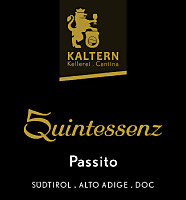
|
|
Alto Adige Moscato Giallo Passito Quintessenz 2016 |
|
| Kellerei Kaltern - Caldaro (Alto Adige, Italy) | |
 Moscato Giallo Moscato Giallo | |
| Price: € 35.00 - 375ml | Score: |
 Brilliant amber yellow and nuances of amber yellow, transparent. Brilliant amber yellow and nuances of amber yellow, transparent. Intense, clean, pleasing, refined and elegant, starts with hints of
raisin, dried apricot and passion fruit followed by aromas of white rose,
citrus peel, lavender, mango, dried fig, date, candied fruits, quince jam,
sage, honey, hazelnut, nail polish and vanilla. Intense, clean, pleasing, refined and elegant, starts with hints of
raisin, dried apricot and passion fruit followed by aromas of white rose,
citrus peel, lavender, mango, dried fig, date, candied fruits, quince jam,
sage, honey, hazelnut, nail polish and vanilla.
 Sweet and round attack, however balanced by alcohol, good body, intense
flavors, pleasing crispness. Sweet and round attack, however balanced by alcohol, good body, intense
flavors, pleasing crispness.
 Very persistent finish with long flavors of raisin, dried apricot and
passion fruit. Very persistent finish with long flavors of raisin, dried apricot and
passion fruit.
 24 months in cask. 24 months in cask. |
|
 Confectionery, Fruit tarts, Hard and piquant cheese Confectionery, Fruit tarts, Hard and piquant cheese |
|
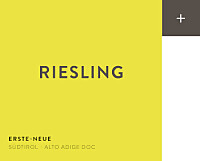
|
|
Alto Adige Riesling 2019 |
|
| Erste+Neue (Alto Adige, Italy) | |
 Riesling Riesling | |
| Price: € 11.50 | Score: |
 Brilliant greenish yellow and nuances of greenish yellow, very
transparent. Brilliant greenish yellow and nuances of greenish yellow, very
transparent.
 Intense, clean, pleasing and refined, starts with hints of apple,
citron and peach followed by aromas of pear, lychee, grapefruit, pineapple,
broom, hazelnut, thyme and mineral. Intense, clean, pleasing and refined, starts with hints of apple,
citron and peach followed by aromas of pear, lychee, grapefruit, pineapple,
broom, hazelnut, thyme and mineral.
 Crisp attack and however balanced by alcohol, good body, intense
flavors, agreeable. Crisp attack and however balanced by alcohol, good body, intense
flavors, agreeable.
 Persistent finish with flavors of peach, citron and lychee. Persistent finish with flavors of peach, citron and lychee. Aged in steel tanks. Aged in steel tanks. |
|
 Pasta with fish and crustaceans, Sauteed white meat, Sauteed fish, Vegetable flans Pasta with fish and crustaceans, Sauteed white meat, Sauteed fish, Vegetable flans |
|
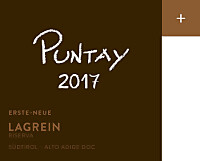
|
|
Alto Adige Lagrein Riserva Puntay 2017 |
|
| Erste+Neue (Alto Adige, Italy) | |
 Lagrein Lagrein | |
| Price: € 15.90 | Score: |
 Deep ruby red and nuances of ruby red, little transparency. Deep ruby red and nuances of ruby red, little transparency. Intense, clean, pleasing and refined, starts with hints of blackberry,
black cherry and plum followed by aromas of violet, blueberry, cocoa,
tobacco, mace, vanilla and eucalyptus. Intense, clean, pleasing and refined, starts with hints of blackberry,
black cherry and plum followed by aromas of violet, blueberry, cocoa,
tobacco, mace, vanilla and eucalyptus.
 Properly tannic attack and however balanced by alcohol, full body,
intense flavors, pleasing roundness. Properly tannic attack and however balanced by alcohol, full body,
intense flavors, pleasing roundness.
 Persistent finish with flavors of blackberry, black cherry and plum. Persistent finish with flavors of blackberry, black cherry and plum. 18 months in barrique and cask. 18 months in barrique and cask. |
|
 Game, Roasted meat, Stewed and braised meat, Hard cheese Game, Roasted meat, Stewed and braised meat, Hard cheese |
|
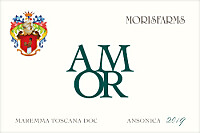
|
|
Maremma Toscana Ansonica Amor 2019 |
|
| Moris Farms (Tuscany, Italy) | |
 Ansonica Ansonica | |
| Price: € 10.90 | Score: |
 Brilliant straw yellow and nuances of greenish yellow, very
transparent. Brilliant straw yellow and nuances of greenish yellow, very
transparent.
 Intense, clean, pleasing and refined, starts with hints of pear, peach
and apple followed by aromas of citron, broom, hawthorn, plum and mineral. Intense, clean, pleasing and refined, starts with hints of pear, peach
and apple followed by aromas of citron, broom, hawthorn, plum and mineral.
 Crisp attack and however balanced by alcohol, good body, intense
flavors, agreeable. Crisp attack and however balanced by alcohol, good body, intense
flavors, agreeable.
 Persistent finish with flavors of pear, peach and apple. Persistent finish with flavors of pear, peach and apple. Aged in steel tanks. Aged in steel tanks. |
|
 Aperitifs, Fish appetizers, Risotto with vegetables, Dairy products, Eggs Aperitifs, Fish appetizers, Risotto with vegetables, Dairy products, Eggs |
|
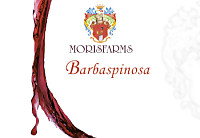
|
|
Maremma Toscana Rosso Barbaspinosa 2017 |
|
| Moris Farms (Tuscany, Italy) | |
 Sangiovese (90%), Cabernet Sauvignon (10%) Sangiovese (90%), Cabernet Sauvignon (10%) | |
| Price: € 13.50 | Score: |
 Intense ruby red and nuances of ruby red, little transparency. Intense ruby red and nuances of ruby red, little transparency. Intense, clean, pleasing and refined, starts with hints of black
cherry, plum and black currant followed by aromas of violet, blueberry,
blackberry, carnation, chocolate, tobacco, vanilla and menthol. Intense, clean, pleasing and refined, starts with hints of black
cherry, plum and black currant followed by aromas of violet, blueberry,
blackberry, carnation, chocolate, tobacco, vanilla and menthol.
 Properly tannic attack and however balanced by alcohol, good body,
intense flavors, agreeable. Properly tannic attack and however balanced by alcohol, good body,
intense flavors, agreeable.
 Persistent finish with flavors of black cherry, plum and black
currant. Persistent finish with flavors of black cherry, plum and black
currant.
 12 months in barrique, 4 months in bottle. 12 months in barrique, 4 months in bottle. |
|
 Broiled meat and barbecue, Roasted meat, Stewed and braised meat with mushrooms, Hard cheese Broiled meat and barbecue, Roasted meat, Stewed and braised meat with mushrooms, Hard cheese |
|
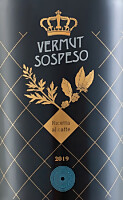
|
|
Vermut Sospeso 2019 |
|
| Bespoke Distillery (Campania, Italy) | |
 Vini italiani e da uve moscato aromatizzati con erbe ed essenze Vini italiani e da uve moscato aromatizzati con erbe ed essenze | |
| Price: € 29.00 | Score: |
 Dark amber yellow and nuances of amber yellow, moderate transparency. Dark amber yellow and nuances of amber yellow, moderate transparency. Intense, clean, pleasing and refined, starts with hints of coffee,
citrus peel and hazelnut followed by aromas of dried fig, artemisia,
rhubarb, almond, sandal wood and vanilla. Intense, clean, pleasing and refined, starts with hints of coffee,
citrus peel and hazelnut followed by aromas of dried fig, artemisia,
rhubarb, almond, sandal wood and vanilla.
 Sweet and properly tannic attack, however balanced by alcohol, good
body, intense flavors, pleasing roundness. Sweet and properly tannic attack, however balanced by alcohol, good
body, intense flavors, pleasing roundness.
 Persistent finish with flavors of coffee, rhubarb and artemisia with
hints of sweetness and bitterness. Persistent finish with flavors of coffee, rhubarb and artemisia with
hints of sweetness and bitterness.
 Produced with fortified and aromatized Italian wines. Produced with fortified and aromatized Italian wines. |
|
 Confectionery Confectionery |
|
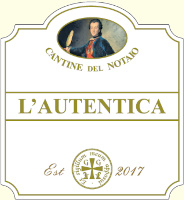
|
|
L'Autentica 2017 |
|
| Cantine del Notaio (Basilicata, Italy) | |
 Moscato Bianco (70%), Malvasia Bianca (30%) Moscato Bianco (70%), Malvasia Bianca (30%) | |
| Price: € 29.90 - 500ml | Score: |
 Brilliant amber yellow and nuances of amber yellow, moderate
transparency. Brilliant amber yellow and nuances of amber yellow, moderate
transparency.
 Intense, clean, pleasing, refined and elegant, starts with hints of
raisin, pear and candied fruits followed by aromas of dried apricot, dried
fig, honey, citrus peel, date, almond, lavender, lychee, nail polish and
vanilla. Intense, clean, pleasing, refined and elegant, starts with hints of
raisin, pear and candied fruits followed by aromas of dried apricot, dried
fig, honey, citrus peel, date, almond, lavender, lychee, nail polish and
vanilla.
 Sweet and round attack, however balanced by alcohol, good body, intense
flavors, pleasing crispness. Sweet and round attack, however balanced by alcohol, good body, intense
flavors, pleasing crispness.
 Persistent finish with flavors of raisin, candied fruits and dried fig. Persistent finish with flavors of raisin, candied fruits and dried fig. 12 months in barrique, 12 months in bottle. 12 months in barrique, 12 months in bottle. |
|
 Hard and piquant cheese, Fruit tarts, Confectionery Hard and piquant cheese, Fruit tarts, Confectionery |
|
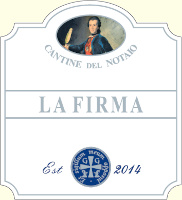
|
|
Aglianico del Vulture Superiore La Firma 2014 |
|
| Cantine del Notaio (Basilicata, Italy) | |
 Aglianico Aglianico | |
| Price: € 31.20 | Score: |
 Intense ruby red and nuances of ruby red, little transparency. Intense ruby red and nuances of ruby red, little transparency. Intense, clean, pleasing, refined and elegant, starts with hints of
plum, blackberry and black cherry followed by aromas of violet, blueberry,
carob, chocolate, mace, tobacco, leather, licorice, vanilla and menthol. Intense, clean, pleasing, refined and elegant, starts with hints of
plum, blackberry and black cherry followed by aromas of violet, blueberry,
carob, chocolate, mace, tobacco, leather, licorice, vanilla and menthol.
 Properly tannic attack and however balanced by alcohol, full body,
intense flavors, pleasing crispness. Properly tannic attack and however balanced by alcohol, full body,
intense flavors, pleasing crispness.
 Persistent finish with flavors of black cherry, blackberry and plum. Persistent finish with flavors of black cherry, blackberry and plum. 12 months in cask, 12 months in bottle. 12 months in cask, 12 months in bottle. |
|
 Game, Roasted meat, Braised and stewed meat, Hard cheese Game, Roasted meat, Braised and stewed meat, Hard cheese |
|

|
|
Bacco 2018 |
|
| Siddura (Sardinia, Italy) | |
 Cagnulari Cagnulari | |
| Price: € 20.50 | Score: |
 Intense ruby red and nuances of ruby red, little transparency. Intense ruby red and nuances of ruby red, little transparency. Intense, clean, pleasing, refined and elegant, starts with hints of
cherry, blueberry and plum followed by aromas of violet, raspberry,
geranium, pomegranate, chocolate, laurel, tobacco, moss, vanilla and
menthol. Intense, clean, pleasing, refined and elegant, starts with hints of
cherry, blueberry and plum followed by aromas of violet, raspberry,
geranium, pomegranate, chocolate, laurel, tobacco, moss, vanilla and
menthol.
 Properly tannic attack and however balanced by alcohol, good body,
intense flavors, pleasing roundness. Properly tannic attack and however balanced by alcohol, good body,
intense flavors, pleasing roundness.
 Persistent finish with flavors of cherry, blueberry and plum. Persistent finish with flavors of cherry, blueberry and plum. Aged in steel tanks and in cask. Aged in steel tanks and in cask. |
|
 Stuffed pasta, Broiled meat and barbecue, Roasted meat, Stewed meat with mushrooms Stuffed pasta, Broiled meat and barbecue, Roasted meat, Stewed meat with mushrooms |
|

|
|
Moscato di Sardegna Passito Nuali 2018 |
|
| Siddura (Sardinia, Italy) | |
 Moscato Bianco Moscato Bianco | |
| Price: € 20.50 - 375ml | Score: |
 Pale amber yellow and nuances of golden yellow, transparent. Pale amber yellow and nuances of golden yellow, transparent. Intense, clean, pleasing, refined and elegant, starts with hints of
raisin, citrus peel and peach jam followed by aromas of candied fruits,
dried apricot, lychee, quince, honey, passion fruit, lavender and date. Intense, clean, pleasing, refined and elegant, starts with hints of
raisin, citrus peel and peach jam followed by aromas of candied fruits,
dried apricot, lychee, quince, honey, passion fruit, lavender and date.
 Sweet and round attack, however balanced by alcohol, good body, intense
flavors, pleasing crispness. Sweet and round attack, however balanced by alcohol, good body, intense
flavors, pleasing crispness.
 Persistent finish with flavors of raisin, peach jam and lychee, Persistent finish with flavors of raisin, peach jam and lychee, Aged in steel tanks. Aged in steel tanks. |
|
 Dried fruit and jam tarts, Confectionery, Piquant cheese Dried fruit and jam tarts, Confectionery, Piquant cheese |
|
News |
|
In this section are published news and information about events concerning the world of wine and food. Whoever is interested in publishing this kind of information can send us a mail to our address.
|
AquavitaeReview of Grappa, Distillates and Brandy |
|
|
||||||||||||
Wine Guide ParadeNovember 2020
|
| |||||||
Privacy Policy | |||||||


| Copyright © 2002-2024 Antonello Biancalana, DiWineTaste - All rights reserved |
| All rights reserved under international copyright conventions. No part of this publication and of this WEB site may be
reproduced or utilized in any form or by any means, electronic or mechanical, without permission in writing from DiWineTaste. |